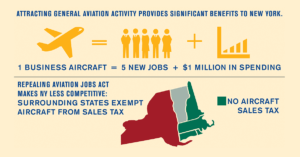 NBAA encourages its New York members to make their voices heard against proposals in the state legislature that, if enacted, would eliminate the Aviation Jobs Act (AJA) that has driven key aviation investment across the Empire State.
NBAA encourages its New York members to make their voices heard against proposals in the state legislature that, if enacted, would eliminate the Aviation Jobs Act (AJA) that has driven key aviation investment across the Empire State.
Enacted as part of the 2015 state budget, the AJA made New York competitive with surrounding states that had already enacted similar sales-and-use tax exemptions to grow aviation business. Despite these positives, however, New York State Senate Bill 7135 and Assembly Bill 9053 would eliminate the AJA, cutting jobs and jeopardizing investments made to the state’s aviation industry.
NBAA has issued a call to action in support of the AJA, encouraging members to join with efforts by local business aviation groups against the state senate and assembly bills that would end this important provision. Review NBAA’s call to action.
“We are extremely concerned about these attempts to remove a key driver for aviation investment across New York,” said Scott O’Brien, NBAA senior director for government affairs. “NBAA worked for many years to secure passage of this pro-growth legislation, and the time for our industry to make our voices heard to preserve it is now.”
In the five years since the AJA was enacted, a leading aeromedical provider established its flight operations center at Schenectady County Airport (SCH), bringing high-paying jobs to the area. A new general aviation (GA) customs facility opened at Plattsburgh International Airport (PBG) and Long Island MacArthur Airport (ISP) invested in new GA facilities, among other aviation-related developments across the state.
“Incredibly, this legislation seeks to repeal the AJA that has already resulted in the location at New York airports of several revenue-producing and job-creating business jets and their aviation-related activity as was predicted by AJA sponsors and supporters,” wrote the New York Aviation Management Association. “NYS DOT strongly recommended creating incentives for attracting business jets to NY airports. Their data shows that on average each business jet means 5 direct on-airport jobs and $1 million in annual economic activity for the state in which it is located.”
